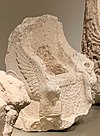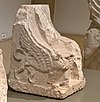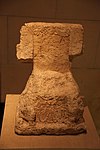

Places associated with the Thrones of Astarte
The Thrones of Astarte are approximately a dozen ex-voto "cherubim" thrones found in ancient Phoenician temples in Lebanon, in particular in areas around Sidon, Tyre and Umm al-Amad.[1] Many of the thrones are similarly styled, flanked by cherubim-headed winged lions on either side.[2] Images of the thrones are found in Phoenician sites around the Mediterranean, including an ivory plaque from Tel Megiddo (Israel), a relief from Hadrumetum (Tunisia) and a scarab from Tharros (Italy).[2]
| Image | Period | Location found | Current location | Inscription | Description | First published |
|---|---|---|---|---|---|---|
 |
Hellenistic | Byblos | National Museum of Beirut | none | On the front, two figures pouring a libation into a flower. On the seat, rectangular anathyrosis for placing an object.[3] | Dunand[4] |
 |
Hellenistic | Sidon | National Museum of Beirut | none | On the front, a Phoenician palmette. On the seat, a large rectangular mortise used to fix an object. Backrest without decoration.[3] | 1941 Dunand[5] |
 |
Roman | Sidon | National Museum of Beirut | Greek inscription | Seat very tilted, unable to hold an object. The back shows a globe inside a crescent.[3] | 1924[6] |
 |
Sidon | Louvre | none | Naiskos in which is a throne with two sphinxes. Above the seat, U-shaped cavity, intended to receive an object rounded at the bottom: perhaps a round baetyl and its crowns. On the side faces, officiating priests.[3] | 1933[7] | |
 |
Sidon | Istanbul Archaeology Museums | none | Naiskos analogous to the previous one. At the back is a small cavity, intended to hold an object. On the sides, winged goddesses of Egyptian style.[3] | [8] | |
 |
2nd century BCE | Khirbet et-Tayibeh, near Ras al-Ain near Tyre | Louvre | Phoenician dedication to Astarte, known as KAI17 | On the throne, two stelae with reliefs, depicting two standing officiants.[3] | 1907 Ronzevalle[9][10][11] |
 |
Hellenistic | Ain Baal near Tyre | National Museum of Beirut | none | Seat contains a stele or baetyl[3] | |
 |
Hellenistic | Region of Tyre | National Museum of Beirut | none | Seat contains a stele or baetyl[3] | |
 |
4th century BCE | Umm al-Amad | Louvre | none | On the front, a Phoenician palmette[3] | 1860, Renan[12] |
 |
Umm al-Amad | National Museum of Beirut | none | The front is broken. Horizontal seat, rounded front. Backrest without decoration. Large throne which could fit a person.[3] | Dunand | |
 |
Temple of Eshmun | Temple of Eshmun | none | Dunand | ||
 |
Temple of Eshmun | National Museum of Beirut | none | Dunand | ||
 |
Hellenistic | Unknown | National Museum of Beirut | none |